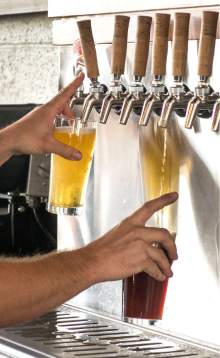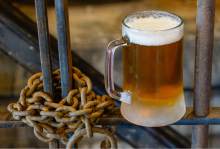This is an archived article that was published on sltrib.com in 2017, and information in the article may be outdated. It is provided only for personal research purposes and may not be reprinted.
Grocery and convenience stores in Utah sell the majority of the beer in the state — more than 94 percent, about 32.4 million gallons, annually — statistics show.
But what happens in two years, if the availability of 3.2 percent beer decreases and only higher-alcohol beers are available from big brands like Anheuser-Busch and MillerCoors?
Could the Utah Department of Alcoholic Beverage Control handle the purchasing, storage and distribution of the product?
No way, DABC officials said Wednesday during a presentation to the Legislature's business and labor interim committee.
"The volume of beer that is being sold in the convenience stores and grocery stores is five times all the wine, heavy beer and spirits we sell at state liquor stores," DABC Executive Director Sal Petilos said. "The DABC cannot realistically replace that market if there is a complete reduction of 3.2 beer."
Petilos said the DABC doesn't have the staff or warehouse and liquor store space to handle the volume.
Under state law, grocery and convenience stores can sell only beer that is 3.2 percent alcohol by weight (or 4 percent alcohol by volume).
Anything with a higher alcohol content must be sold at state liquor stores.
Beer wholesalers and retailers would like the Utah Legislature to change the law to allow for higher-alcohol beer in stores. But in recent years, lawmakers, many of whom are Mormon and abstain from alcohol, have been hesitant to amend any Utah law that might increase consumption or affect underage drinking.
Actions in other states may force lawmakers to make a change.
Only five states in the country now require 3.2 beer to be sold in grocery and convenience stores. During the next two years, those numbers will dwindle as Colorado, Kansas and Oklahoma have made changes to their liquor laws and will permit stronger beer to be sold in grocery stores.
When those changes take place, only Utah and Minnesota will have the weaker beer requirements, and the percentage of the lighter beers would drop from 1.8 percent of all the beer brewed in the United States to 0.6 percent, said Petilos.
The big question, he said, is "Will the big brewers continue to produce a specialty item in a shrinking market?" Basic economic principles would say no, "that it would become marginally less cost effective."
At the very least, 3.2 beer will become a specialty product that might have higher prices and limited availability, he said.
Utah brewers have said they would step in and fill the 3.2 void, but Petilos said it is unclear whether they have the capacity to meet the demand for the entire state. Limited availability would also affect beer on tap at taverns, beer-only restaurants and recreational sites, such as golf courses and bowling alleys.
If 3.2 beer is reduced or eliminated, it would affect the bottom line for many businesses, warned Sen. Ralph Okerlund, R-Monroe.
"I know there are a lot of businesses in my district where a large percent of their profit comes from sale of beer," he said. "It's a big part of their business."
One solution would be to raise the permissible alcohol level from 3.2 percent to 4.8 percent, said David Davis, president and chief legal officer at Utah Food Industry Association/Utah Retail Merchants Association.
"We don't have to go where the other states have gone and uncap the alcohol content," he told the committee. "By moving the alcohol content from 3.2 to 4.8, you are going to capture the lion's share of the production-line beer that is out there, and consumers would not see some of these negative effects."
Besides lessening the impact on consumers, Davis said, it would help the state's image with tourists and businesses that may be considering moving their companies to the state.
"These sort of lifestyle issues come in to play," he said. "It's one more quirky thing about Utah that is added to a pile of other quirky things."
Utah lawmakers have time to make changes. Oklahoma's law doesn't take effect until October 2018. The changes in Colorado and Kansas take effect in 2019.





